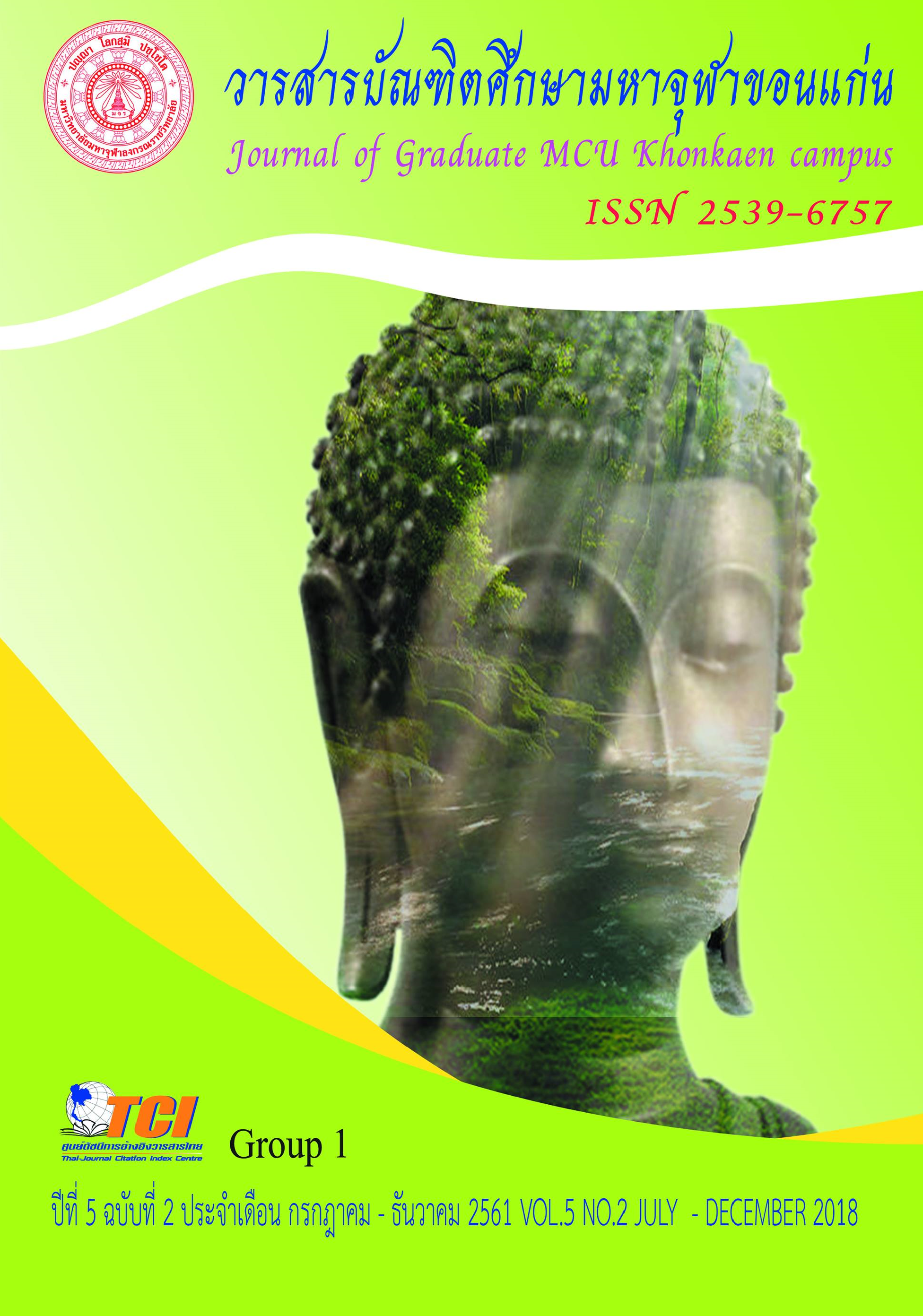การอธิบายธรรมด้วยหลักเหตุผลในคัมภีร์อรรถกถาพระสุตตันตปิฎก
Main Article Content
บทคัดย่อ
บทความวิจัยนี้มีวัตถุประสงค์ 3 ข้อ ได้แก่ 1) เพื่อศึกษาวิธีการอธิบายธรรมด้วยหลักเหตุผลในคัมภีร์พระพุทธศาสนา 2) เพื่อศึกษาวิธีการอธิบายธรรมด้วยหลักเหตุผลในคัมภีร์อรรถกกถาพระสุตตันตปิฎก 3) เพื่อศึกษาความสมเหตุสมผลของการอธิบายธรรมด้วยหลักเหตุผลในคัมภีร์อรรถกถาพระสุตตันตปิฎก เป็นการวิจัยเชิงคุณภาพ เน้นการศึกษาเอกสารเป็นหลัก สรุปผลการวิจัยได้ดังนี้
วิธีการอธิบายธรรมด้วยหลักเหตุผลในคัมภีร์พระพุทธศาสนา มี 6 วิธี ได้แก่ 1) การอธิบายธรรมจากจุดเล็กขยายไปสู่จุดใหญ่ เช่นการจำแนกขันธ์ 5 ของปัจเจกบุคคลขยายไปสู่ขันธ์ 5 ในอดีต อนาคตและปัจจุบัน 2) การอธิบายธรรมจากจุดใหญ่มาสู่จุดเล็ก หรือจากเรื่องสากลมาสู่เรื่องเฉพาะ ภาษาตรรกเรียกว่า การใช้เหตุผลแบบนิรนัย เช่น อธิบายสังสารวัฏ 3) การอธิบายธรรมเชิงเปรียบเทียบ เช่น เปรียบเทียบขันธ์ 5 กับสภาพแวดล้อม เป็นต้น 4) การอธิบายธรรมแบบอนุมาน มี 2 ลักษณะ คือ (1) อนุมานคุณธรรมของพระพุทธเจ้าองค์ปัจจุบันกับพระพุทธเจ้าในอดีตและอนาคต ในสัมปสาทนียสูตร (2) อนุมานตนเองกับผู้อื่น ในอนุมานสูตร (5) การอธิบายธรรมแบบสมมติเหตุการณ์ โดยการเล่าเรื่องในอดีตที่ผู้ฟังเคยได้ฟังมาแล้ว เช่น ในอุปาลิวาทสูตร (6) การอธิบายธรรมแบบกระบวนการ มีขั้นตอนวิธีการในการถาม และการตอบอย่างเป็นระบบในคัมภีร์กถาวัตถุ
วิธีการอธิบายธรรมด้วยหลักเหตุผลในคัมภีร์อรรถกกถาพระสุตตันตปิฎก มีการอธิบายคล้ายกับพระไตรปิฎก กล่าวคือการอธิบายธรรมด้วยหลักเหตุผลเชิงอุปมาอุปไมย เหตุผลแบบยกตัวอย่าง เหตุผลเชิงเป็นเหตุปัจจัย เหตุผลเชิงปฏิปุจฉา เหตุผลอิงกับเมตตากรุณา เหตุผลเชิงอุปมาและอิงกับสรีรศาสตร์ เหตุผลเชิงการสร้างความเชื่อมั่น เหตุผลเทียบเคียงทัศนะอื่น เหตุผลเชิงรักษาศาสนา เหตุผลเชิงสันติ เหตุผลเชิงอุปมาอุปไมยคุณค่าชีวิตกับวัตถุ เหตุผลที่อิงกับความจริง เหตุผลเชิงความอัศจรรย์ เหตุผลเชิงความหมายครอบคลุม เหตุผลเชิงสัจภาวะ เหตุผลแบบเล่าเรื่องอดีต เหตุผลเชิงปฏิบัติ เหตุผลเชิงปฏิบัติต่อครุฐานีย์ เหตุผลเชิงนิคคหะและอนุคคหะ เหตุผลเชิงคุณธรรม เหตุผลเชิงธรรมชาติ เหตุผลเชิงความจริงเชิงประจักษ์ เหตุผลเชิงสัมพันธ์ระหว่างบทบาทกับความสามารถ เหตุผลเชิงสัททศาสตร์ เหตุผลด้านความสามารถ เหตุผลแบบปฏิปุจฉาและอุปมา เหตุผลเชิงความจริงตามหลักสังคหวัตถุและเหตุผลเชิงปฏิภาณ
ความสมเหตุสมผลของการอธิบายธรรมด้วยหลักเหตุผลในคัมภีร์อรรถกถาพระสุตตันตปิฎก มีดังนี้
ความสมเหตุสมผลในการอธิบายธรรมเชิงอุปมาอุปไมย มีความเป็นเหตุเป็นผล และมีตัวอย่างประกอบ ซึ่งตัวอย่างเป็นตัวอย่างที่มีทั้งสภาพจริงในชีวิต สภาวธรรมตามปรมัตถธรรม และเรื่องราวในอดีตชาติหรือชาดก ทำให้ผู้ศึกษาคัมภีร์ชั้นอรรถกถาเข้าใจธรรมอย่างชัดเจน เช่น การอธิบายนิวรณ์ 5 อย่างมีกามฉันทะเป็นต้นเหมือนคนเป็นหนี้ เป็นต้น การอธิบายธรรมเชิงอุปมาอุปไมยนี้นับว่าเป็นเครื่องมือในการอธิบายธรรมอย่างขาดมิได้ ถ้าไม่มีการอธิบายอย่างนี้ ความงามและอรรถรสของภาษาย่อมหมดไป ที่สำคัญความเข้าใจหลักธรรมในด้านสภาวธรรมย่อมเกิดขึ้นได้ยาก
ความสมเหตุสมผลในการอธิบายธรรมด้วยเหตุผลเชิงเหตุปัจจัย ทำให้เห็นสภาวธรรมที่อุดหนุนซึ่งกันและกันให้บริสุทธิ์ เช่น ปัญญาและศีลต่างชำระกันให้บริสุทธิ์ได้ ดังกรณีของพระเถระได้ใช้ความบริสุทธิ์แห่งศีลที่ท่านรักษาดีมาตลอด 60 พรรษา ข่มเวทนาได้และบรรลุอรหัตผล ส่วนสันตติมหาอำมาตย์ไม่ได้รักษาศีลเหมือนพระเถระ แต่เป็นแม่ทัพและดื่มสุราเมาตลอด 7 วัน วันที่ 7 เกิดความทุกข์เพราะหญิงอันเป็นที่รักตายไป ได้ฟังพระคาถาเกี่ยวกับการตัดกิเลสเครื่องกังวลทั้งในอดีตและที่จะมีในอนาคตและการไม่ยึดขันธ์ถือขันธ์ในท่ามกลาง เป็นผู้สงบระงับเที่ยวไป
ความสมเหตุสมผลในการอธิบายธรรมด้วยเหตุผลเชิงอุปมาอุปไมย มีหลายวิธี กล่าวคือ การเห็นพระอริยะด้วยตาเนื้อและตาปัญญา การเห็นพระอริยะด้วยตาเนื้อยังไม่ใช่การเห็นที่แท้จริง ส่วน การเห็นที่แท้จริงคือเห็นด้วยตาปัญญา การอธิบายผู้สำรวมด้วยการสังวรในจักขุนทรีย์ คือ ผู้มีสติสังวร หากไม่มีสติสังวรก็เหมือนนครที่มิได้ปิดประตู โจรทั้งหลายย่อมเข้าปล้นนครและบ้านเรือนราษฎรได้ง่าย เมื่อมีสติสังวรในจักขุนทรีย์เป็นต้น ดีแล้ว ก็เหมือนนครที่ปิดประตูอย่างดี โจรทั้งหลายย่อมไม่สามารถเข้าปล้นนครและบ้านเรือนราษฎรได้ การอธิบายสติสัมโพชฌงค์ องค์แห่งการตรัสรู้ เพราะมีความระลึกได้ ไม่ฟั่นเฟือน ไม่หลงลืม เหมือนขุนคลังของพระราชาที่สามารถชี้แจงทรัพย์สินในท้องพระคลังหลวงได้อย่างชัดเจน ความเป็นธรรมทายาทย่อมรักษาศาสนาไว้ได้ อาหาร 4 เป็นปัจจัยแห่งการดำรงชีวิตของสรรพสัตว์ทั้งมนุษย์ สัตว์ดิรัจฉานและเทวดาทั้งหลาย ซึ่งมีทั้งอาหารหยาบและอาหารละเอียด (ทิพย์) กวฬิงการาหารอุปมาด้วยเนื้อบุตร ผัสสาหารอุปมาด้วยแม่โคถูกถลกหนัง มโนสัญเจตนาหารอุปมาด้วยหลุมถ่านเพลิง วิญญาณาหารอุปมาด้วยการถูกแทงด้วยหอก 100 เล่ม
The objectives of this research were: 1) to study the dhamma explanation by using the reasons in the Buddhist texts; 2) to study the explanation methods by using the reasons in the Commentaries of Suttanta Tipiṭaka; 3) to study the reasonableness of the dhamma explanation by reasoning principles in the Commentaries of Suttanta Tipiṭaka. This qualitative study was conducted by means of documentary research and its conclusions are as follows:
There are six methods for explaining the dhamma according to the Buddhist texts : (1) explanation from a small viewpoint to a bigger one; such as, classification of the Five Aggregates of the individual before classifying those in the past, future and present; (2) explanation from a board viewpoint to a smaller one or from the universal to the specific, this is called Deductive Reasoning in logic terms, such as explaining the concept of the Cycle of Existence or Samsara; (3) comparative explanation such as comparing the Five Aggregates with its environment; (4) inference explanation categorized in two aspects: 1) inference of the Buddha virtues in the present with those in the past and future, this can be seen in the Sampasādanīya Sutta; 2) oneself-inference with the others as seen in the Anumān Sutta; (5) explanation by the event exampling through telling stories in the past that the audiences used to hear before, this seen in Upālivāda Sutta; (6) dhamma explanation in processes started by questioning and systematically answering as seen in the Kathāvatthu Text.
The dhamma explanation by using the reasons in the Commentaries of Suttanta Tipiṭaka is similar to methods seen in the Tipiṭaka. They are metaphorical reasoning, example reasoning, causal reasoning, questioning-in-return reasoning, reasoning based on loving kindness and compassion, metaphorical reasoning based on physiology, convincing reasoning, reasoning by comparing with others’ attitudes, religious preservation reasoning, peaceful reasoning, metaphysical reasoning between life values and materials, reasoning by referring to the truth, miracle reasoning, reasoning in terms of overall meaning, logical reasoning, past storytelling reasoning, practical reasoning, reasoning as a teacher, reasoning by ‘niggaha’ and ‘anuggaha’, moral reasoning, natural reasoning, empirical truth reasoning, reasoning related to roles and abilities, sociological reasoning, capacity reasoning, returned questioning and metaphorical reasoning based on the truth according to the principles of Four Bases of Social Solidarity (saṅgahavatthu-dhamma) and reasoning based intellectual competency.
Reasonableness of the dhamma explanation by using the reasons in the Commentaries of the Suttanta Tipiṭaka can be seen as follows:
Reasonableness in the metaphorical dhamma explanation relies on reasonableness and examples of a real life, transcendental dhamma condition, the stories in the past or Jātaka; this makes those who studied the Commentaries understand the dhamma clearer; for example, to explain the concept of the Five Hindrances, the sensual desire is metaphorically compared with people with debt. The metaphorical explanation is one of the excellent tools for explaining the dhamma, without this, the beauty and language flavor are lost; importantly, comprehension in the dhamma conditions hardly happens.
Reasonableness in the cause-effect explanation of the dhamma leads to the realization of the dependent dhammas; for example, wisdom and precepts mutually function and lead to the purity as can be seen in the case of the senior monk who used his purity of precepts having observed for 60 years to overcome the feelings and to attain the arahantship; Pasha, Santati, the commander in chief, who has never observed the precepts has been drinking for seven days; in the seventh day, he was suffered because of his beloved woman death; after he listened to the dhamma about distinguishing the defilement and worries in the past and non-attachment on the aggregates; later on he was calm down.
Reasonableness of the metaphorical dhamma explanation can be made in a variety of ways; for example, the noble sight can be created by physical eyes and dhamma eyes; the first is not the true sight as the true sight must be created by wisdom; the explanation of those with contemplation on their sight faculty as the one with consciousness contemplation, if not it is like the city with the open gates for robberies and if so, it is like the city with high security; consciousness, one of the enlightenment factors, is like the royal treasurer with good memory in property management; the religious heir can preserve the religion; food is one of the four requisites for living of all beings: human, animal and devas, food is divided in gross and subtle stage; Kavaliṅkārāhāra is like the son’s meat, Bhassāhāra is like a cow without its skin, Manocetanāhāra is like a fire hole, Viññāṅāhāra is like being strapped by a hundred of spears.

